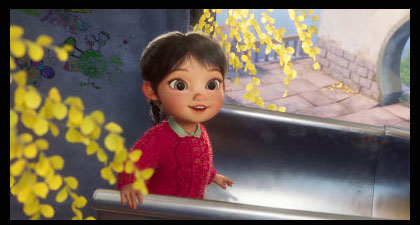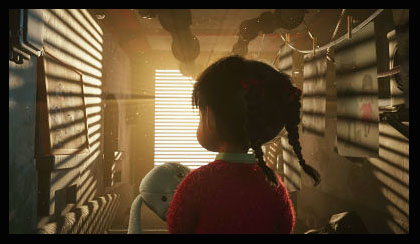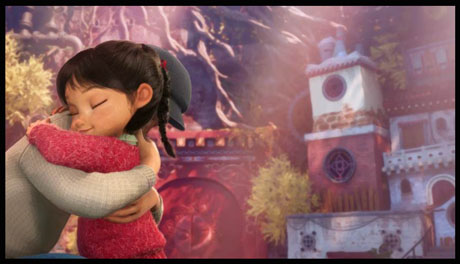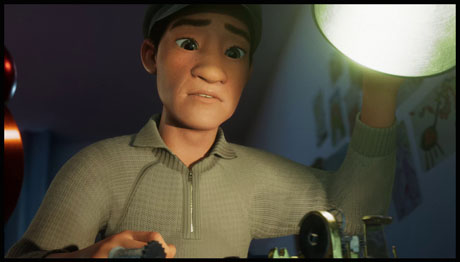
“WiNDUP”, an animated short from Unity, is vying for Academy and Annie Awards consideration. It’s about a sick girl, her dad and a significant, windup music box. Director Yibing Jiang (whose credits include Disney’s Wreck-It Ralph and Pixar’s Cars 2 & Monsters University) and animation director Jason Keane (of Blue Sky’s The Peanuts Movie and Ferdinand) team-up for this touching story with groundbreaking technology.
Jackson Murphy: Yibing, what led to making the windup music box the focal point?
Yibing Jiang: To be honest, we’ve had multiple iterations of the story. At the beginning we had dialogue. Then later, we thought we should go dialogue-free. If we don’t have dialogue, what should we do? How do we communicate? We thought about multiple things, and then the music box idea came to my mind. After so many trials… we changed the story until the very last minute.

Jason Keane: I think it was the perfect vessel to carry the music across. The perfect tonality for this little kid, Kiki, and everything. It was a good choice.
JM: Yes. Jason, you’ve worked on films with children at the center. Was that one of the reasons why you were attracted to this project?

Jason Keane
JM: Yeah, I talked with Glen a couple months ago for Over the Moon and Max [Keane] for Trash Truck! You’re the third one in the past three or four months!
JK: (laughs) It’s getting nuts! Yibing came to me. This is her story. I connected to it. My wife actually became pregnant during the production. This was our first kid. I was able to really reflect on how that father feels in the film. And I love the emotional tone, and especially with the pandemic. Super relatable in all kinds of facets.
JM: It absolutely is. Yibing, one thing viewers will notice early on is that Kiki moves so realistically as she goes down the slide and then the story and then she’s running. How does Unity’s real-time 3D technology work and specifically for that sequence?
YJ: Real-time rendering helped out a lot. Just imagine that animators are the actors in live-action movies. It really helps a lot if they can see the environment and lighting and feel the tone of the movie when they perform. That helped a lot. In traditional animation, what animators see… there’s no accurate lighting and they have to imagine the tone. “Here, it must be sad. Here, it must be happy.” We don’t have to communicate because once you see the thing you can actually feel what the character feels.

JM: Jason, there’s an even balance of lighter and darker scenes. Did you find challenges between the two?
JK: The difference is the emotional tone. To reiterate the real-time rendering, we’re coming from the film industry: Blue Sky, Pixar and DreamWorks. We’ve never seen or messed with this real-time rendering process. And it was really mind blowing to us: kind of a revelation. “We can see that final product just like the audience sees it!” Because of that, we’re able to live the characters, and the faster we live the characters I think the more authentic our performance becomes. With the light and dark type scenes, we’re able to see it. Traditionally, we wouldn’t see the lighting. It’s kind of a basic mock-up lighting that doesn’t give us that feel. When we see Kiki in there and we’re animating, it’s happening instantly. You’re seeing what you see in the film. “Now I kind of know how I should feel!” You’re more 1:1 with the computer and how we’re feeling.

Yibing Jiang
YJ: At the very beginning we knew for our film that the music box is the main character. So the melody of the music should sound like a song you can sing along with instead of ambient background music, like in most films. Fun fact: our producer [Aleksander Karshikoff] did sound effects for like 50 movies before he joined “WiNDUP”. That means he worked with a lot of great composers, which helps a lot. He gave me a long list of demo reels and asked me to pick one that I think fits our storyline the best. So I had my headphones on and listened to all different kinds of music. Our composer, Joaquin Garcia, did a really good job. At the end, everyone working on this film hummed the melody non-stop.
JM: I was humming it a little bit too. This is a short about story and visual details. We see the city Kiki lives in and her and her dad in the hospital. What kinds of visual research went into this?
YJ: I live in San Francisco, so I went to the Botanical Gardens a lot. We searched for images from… the western part of Asia and also some references on Tibet. We wanted it to look realistic, but then we realized that the realistic look would carry too many details and probably wouldn’t work for real-time. We needed to make sure the poly count is not extremely high. So we had to dial back from realism. I was inspired by Eyvind Earle’s art style. He was the background designer for “Sleeping Beauty”. His designs combine realism with illustration. The clean and smooth silhouette and then add back the detail with illustrated patterns. We tried to make sure the silhouette was simple… but then we add back the details with the hand-painted illustrated pattern. And we did the same thing for the characters.

JM: It’s great that you can be inspired by films and artists from decades ago. Obviously Jason, that’s part of your family’s legacy. How do you feel that being a part of “WiNDUP” is worthy of being in your great family catalogue.
JK: For myself as an animator, I’m 100% proud of the project. I believe in the message. I had an experience with my son which echoed the themes. People need this kind of message of hope. In terms of animation, I’m extremely lucky to have my family members guide me throughout my life. The animation style in “WiNDUP”, we had to be careful… walking this fine line between cartoony and realistic. We couldn’t have it be too cartoony or funny, or else it wouldn’t be able to carry that emotional weight within the story. Or it couldn’t be too realistic because it would muddle everything. You want that fun and appeal. It reminded me of when I was in art school and I was showing my uncle some life drawings for tips, and he writes down an Italian word on a piece of paper, “sprezzatura”: art that hides art. He tells me that subtly is key. That kind of rang true with the animation here, to be subtle. It had to be carefully done.
JM: Yibing, I want to shift for a second to you working on “Monsters University” at Pixar. You worked on the specific, key scene where Mike and Sulley meet in the dorm room for the first time. Did you feel pressure in being a part of that scene?
YJ: I actually shaded a lot of props in that environment, but they’re hidden in the background. Most people are just watching Mike and Sulley. “That pencil: mine! That lamp!” I don’t think there was too much pressure when I was working at Pixar because there are so many people working on them. I didn’t work on the most important stuff.

JM: But you did because, just like “WiNDUP”, that movie is all about the details! Everywhere you look at the university. What you did was very important. A lot of people noticed all of that.
YJ: Oh, thank you! I think all the Pixar films are focused on details, and I definitely learned a lot from that. In “WiNDUP”, we carry a lot of details in our story and hopefully people will notice.
JM: I think they will. We’re obviously in a big week for Oscar shortlist voting and the Annie Awards is coming up very soon. What does it mean to you to be in consideration and what would these nominations mean to you?
YJ: To be honest, we hope we get on the shortlist. We don’t want to set our expectations too high. We’re trying to be calm and hopefully something happens.
JK: I think it will mean a lot. I know it would mean so much to Yibing and me. Not just for the glory of it, but I also really think… and I know Yibing does too… that the message of the story rings true to these times. It’s important to have a friend, a doctor, a nurse, a family member… or a film… to inspire hope and never give up. It’s important. And with the real-time rendering, that’s a nice thing to promote for other animators and feature film to dabble or start doing more of that. It really does help and it streamlined everything. We were able to put this together… it worked out really well.
YJ: We feel like we’re changing the history of real-time rendering!
- INTERVIEW: Jeff Fowler On “Knuckles” And “Sonic 3” - April 22, 2024
- INTERVIEW: “Inside Out 2” Director And Producer On Pixar Sequel - April 16, 2024
- INTERVIEW: “Puffin Rock And The New Friends” And 25 Years Of Cartoon Saloon - April 10, 2024


 February 2nd, 2021
February 2nd, 2021  Jackson Murphy
Jackson Murphy  Posted in
Posted in  Tags:
Tags: 






